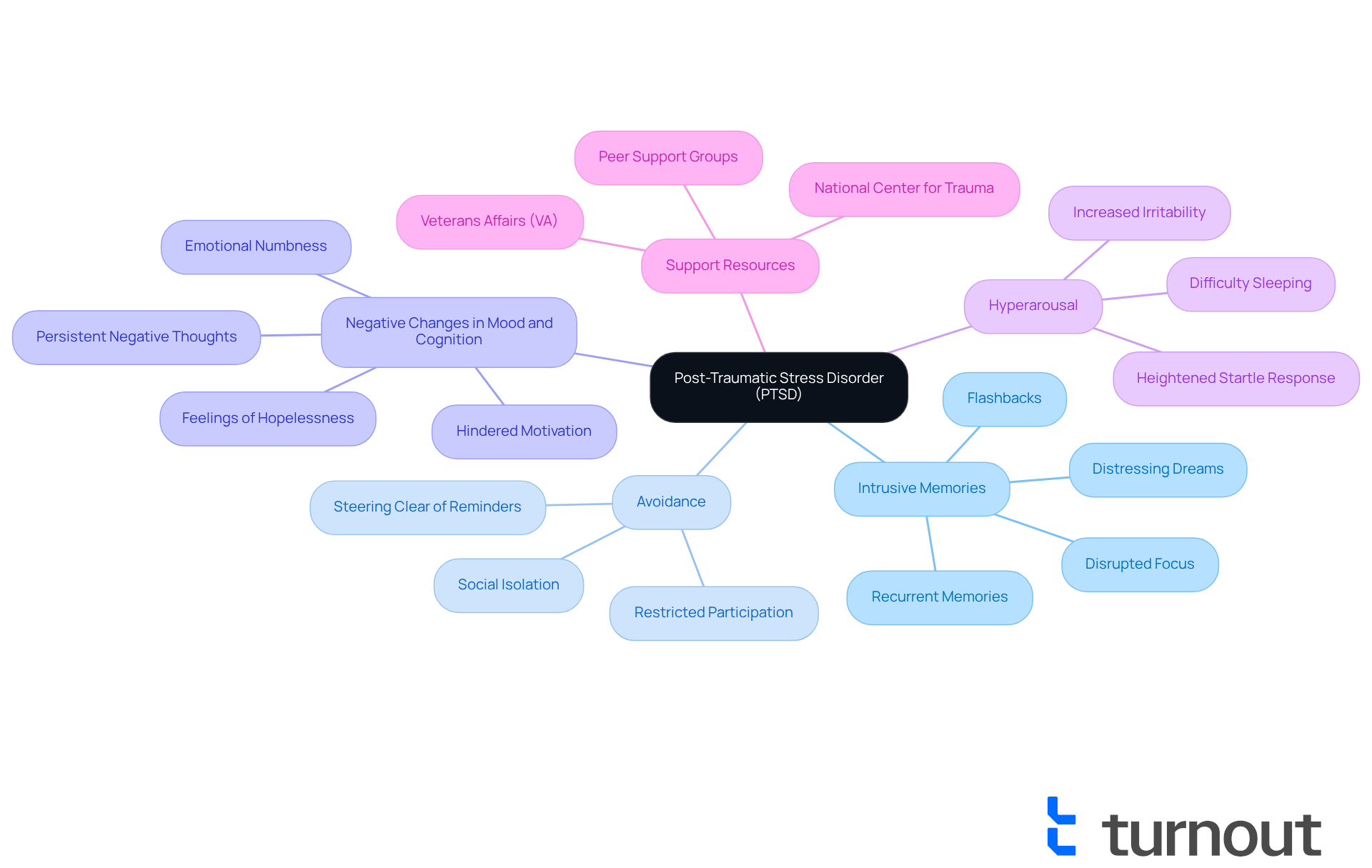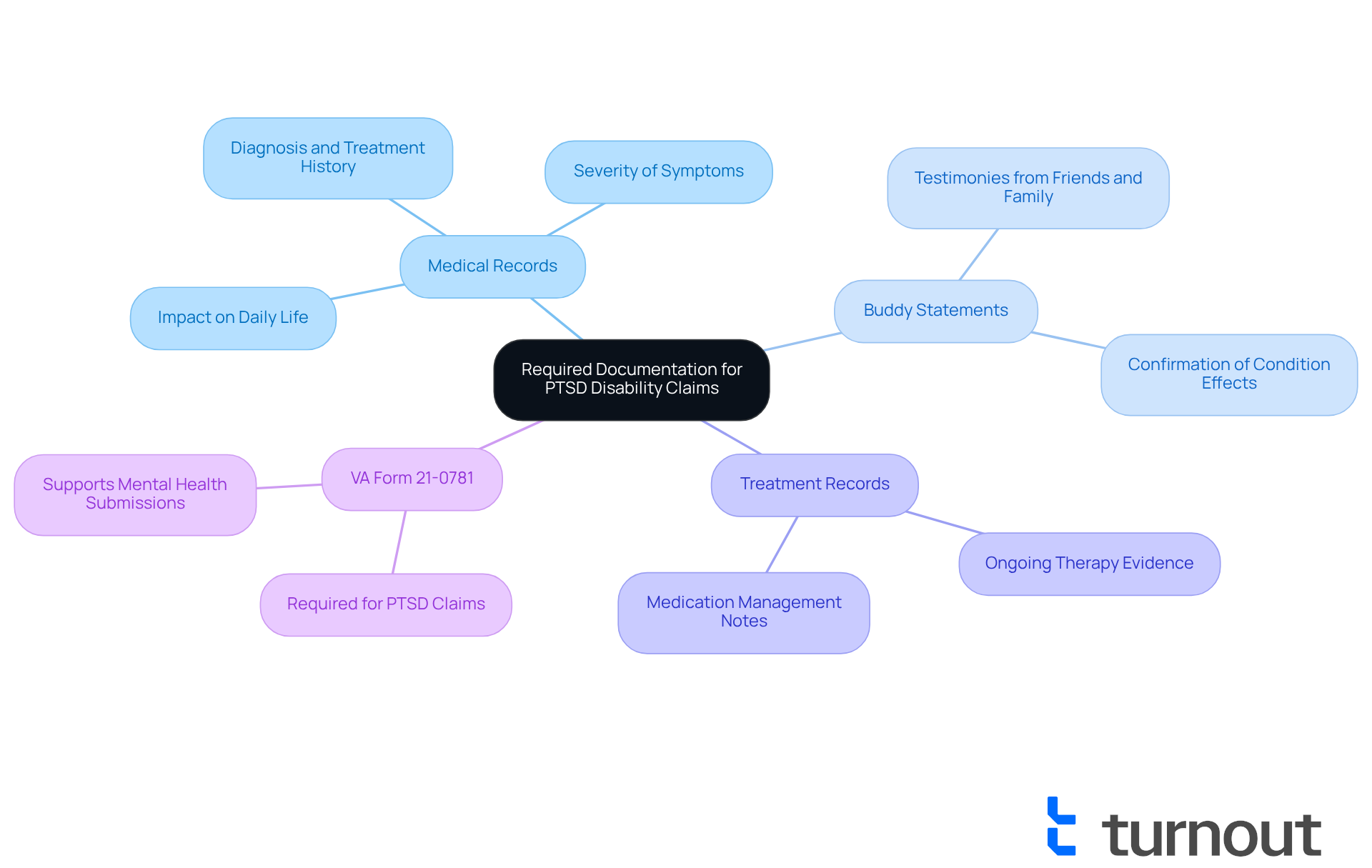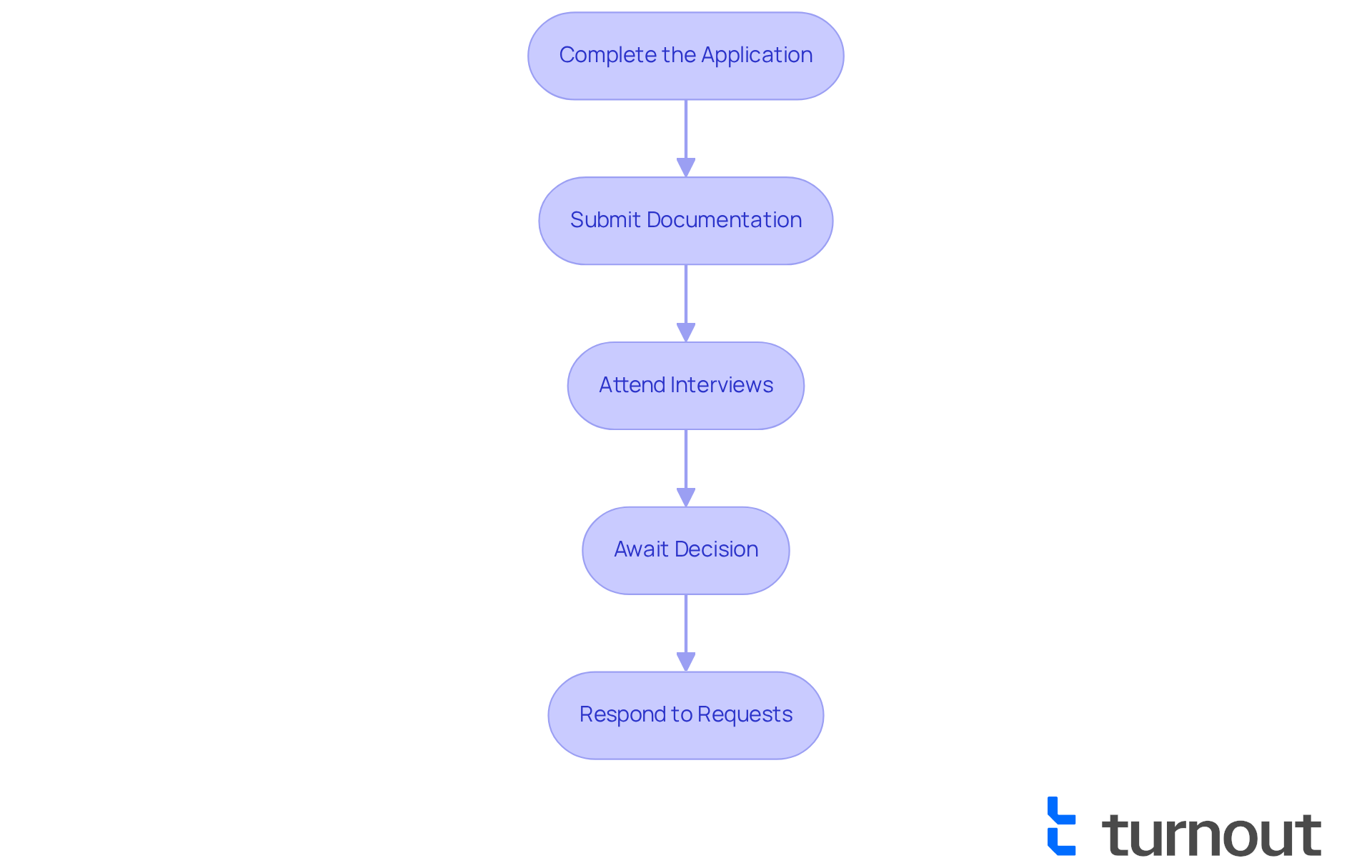Overview
Navigating the process of securing disability benefits for PTSD can feel overwhelming, and we understand that. This article outlines a five-step process designed to guide you through this journey with care and compassion. It emphasizes the importance of understanding how PTSD affects your life, gathering the necessary documentation, and following the application procedure.
We want to help you feel empowered as you take these steps. The article details eligibility criteria, highlights the significance of thorough medical documentation, and discusses how advocacy can enhance your chances of approval. By breaking down these elements, we aim to support you in what can be a daunting experience.
Remember, you are not alone in this journey. We’re here to help you every step of the way, ensuring you have the resources and information needed to move forward with confidence. Together, we can navigate this process and work towards securing the benefits you deserve.
Introduction
Navigating the complexities of securing disability benefits for Post-Traumatic Stress Disorder (PTSD) can be a challenging journey. We understand that this mental health condition, often triggered by traumatic experiences, can disrupt daily life and work performance. It’s essential for individuals to express their struggles effectively. By exploring a structured approach to the application process, you can uncover vital strategies to enhance your chances of approval.
However, it’s common to feel overwhelmed, especially considering that a significant percentage of initial claims are denied. So, what key steps can you take to overcome these hurdles and successfully secure the support you deserve? We're here to help you through this process.
Understand Post-Traumatic Stress Disorder (PTSD)
Post-Traumatic Stress Disorder (PTSD) is a mental health condition that can arise after experiencing or witnessing a traumatic event. We understand that its symptoms can significantly influence daily activities and job performance. This makes it essential for applicants to comprehend and express these effects when pursuing disability for PTSD benefits. Key symptoms include:
- Intrusive Memories: You may experience recurrent, involuntary memories of the trauma, flashbacks, or distressing dreams that disrupt your focus and emotional stability.
- Avoidance: Many individuals steer clear of reminders of the trauma, including people, locations, or activities that provoke distressing memories. This can restrict participation in professional and social environments.
- Negative Changes in Mood and Cognition: Persistent negative thoughts about oneself or others, feelings of hopelessness, and emotional numbness can hinder motivation and productivity.
- Hyperarousal: Symptoms such as increased irritability, difficulty sleeping, and a heightened startle response can create challenges in maintaining a stable professional environment.
Comprehending these symptoms is crucial for effectively expressing how PTSD and the resulting disability for PTSD influence your capacity to work and carry out everyday tasks. Research suggests that approximately 36.6% of adults with PTSD may be eligible for disability for PTSD because they experience serious impairment in their daily lives, which can directly affect job performance. Mental health experts stress that identifying these symptoms not only assists in the process but also promotes a deeper understanding of the condition's impact on overall well-being.
For example, many people find that expressing their experiences makes it simpler to manage the intricacies of processes related to disability for PTSD. By offering specific instances of how PTSD appears in their professional lives, they can navigate the process more easily.
Turnout provides valuable assistance for individuals navigating the SSD claims process. They employ trained nonlegal advocates who can help you express your experiences and comprehend the implications of your symptoms. This approach ensures that you receive the guidance you need without the necessity of legal representation, making the process more accessible. It’s important to note that Turnout is not a law firm and does not provide legal representation.
For more details on trauma-related symptoms and their implications, resources from trustworthy organizations like the National Center for Trauma and the VA can offer further insights. Remember, you are not alone in this journey, and support is available to help you through it.

Determine Eligibility for Disability Benefits
Navigating the path to disability for PTSD benefits can feel overwhelming. We understand that this journey is filled with challenges, and we are here to guide you through it. To qualify for these important benefits related to disability for PTSD, applicants must meet specific criteria set by the Social Security Administration (SSA). Here’s what you need to know:
- Current Work Status: It’s essential to show that you are not currently engaged in substantial gainful activity (SGA), which is defined as earning $1,620 per month for non-blind individuals in 2025.
- Severity of Condition: Your disability for PTSD must significantly impact your ability to function in a work environment. This means demonstrating that the disability for PTSD limits your daily activities, social interactions, and concentration. To qualify for SSDI, you must demonstrate severe restrictions in one area or significant restrictions in two areas of mental functioning, often associated with disability for PTSD.
- Medical Documentation: A diagnosis from a qualified mental health professional is crucial. You will also need evidence of ongoing treatment and the effects of disability for PTSD on your daily life. This includes documentation of exposure to actual or threatened death, serious injury, or violence, alongside a medically documented history spanning at least two years related to disability for PTSD.
Turnout is here to simplify your access to these benefits. We offer trained nonlegal advocates who can assist you through the SSD claims process. It's important to note that Turnout is not a law firm and does not provide legal advice. Recent studies show that about 97% of candidates who complete the process successfully secure SSDI benefits. Those represented by knowledgeable supporters have a remarkable 50% higher chance of receiving benefits. On average, the monthly SSDI benefit is approximately $1,483, providing crucial financial support for those who qualify.
Understanding these criteria can significantly enhance your chances of approval for disability for PTSD. By demonstrating substantial restrictions in essential work activities and providing thorough medical documentation, you can take important steps toward securing the support you need. Remember, you are not alone in this journey, and we are here to help you every step of the way.

Gather Required Documentation and Evidence
When seeking disability for PTSD, we understand that collecting thorough documentation is essential to bolster your request. Key documents include:
-
Medical Records: Detailed documentation from healthcare providers outlining your diagnosis, treatment history, and severity of symptoms is vital. This evidence is crucial, as claims with thorough medical documentation for disability for PTSD have a significantly higher success rate; the average denial rate for disability claims is 68%. Personal statements that illustrate how post-traumatic stress disorder impacts your daily life and work abilities are important for demonstrating disability for PTSD. Many successful candidates emphasize the significance of these personal stories in illustrating the effect of their condition. One candidate remarked, "My personal statement was key in illustrating how PTSD transformed my life."
-
Buddy Statements: Testimonies from friends, family, or colleagues who can confirm your condition and its effects on your life provide additional support. These statements can be instrumental in establishing the credibility of your assertion.
-
Treatment Records: Evidence of ongoing therapy or medication management, including notes from mental health professionals, is necessary to demonstrate your commitment to treatment and the seriousness of your condition.
-
VA Form 21-0781: This document must be filled out when submitting a request for disability for PTSD, as it supports submissions related to mental health issues arising from in-service traumatic incidents.
Organizing these documents systematically will facilitate the application process and significantly improve your chances of approval. Remember, you are not alone in this journey. For further guidance on documentation, we encourage you to refer to the SSA's resource page on filing claims.

Follow the Step-by-Step Application Process
Applying for disability for PTSD benefits can feel overwhelming, but we are here to assist you through the process. Follow these compassionate steps to ease your journey:
- Complete the Application: Start by filling out the SSA's online application or visiting your local SSA office. It's important to ensure that all sections are filled out accurately, as incomplete applications are a common reason for denial.
- Submit Documentation: Along with your application, gather and submit all necessary documentation, including medical records and personal statements that detail how your disability for PTSD affects your daily life. This information is crucial in supporting your claim.
- Attend Interviews: You may be asked to participate in interviews or answer follow-up questions from SSA representatives regarding your condition and its impact on your life. Clear communication during this stage is essential, and we understand that it can be daunting.
- Await Decision: After you submit your application and documentation, the SSA will review everything. This process can take several months, so patience is key. It's common to feel anxious during this time, especially since statistics indicate that around 65-70% of initial submissions are rejected.
- Respond to Requests: If the SSA requests additional information or documentation, please respond promptly to avoid delays in processing your claim. Keeping copies of all submitted forms and documents is advisable for your records, ensuring you have everything organized.
For more detailed instructions, please refer to the SSA's application guide. Remember, you are not alone in this journey, and support is available every step of the way.

Troubleshoot Common Application Challenges
Navigating the process of seeking disability for PTSD can be daunting, and we understand that you may face various challenges along the way. Here are some common issues you might encounter and how to address them:
-
Incomplete Documentation: It's vital to ensure that all required documents are submitted. This includes comprehensive medical documentation, such as treatment notes and evidence of how PTSD symptoms affect your daily life and work. Remember, thorough documentation is essential for a successful request. If you need assistance, Turnout's trained non-professional advocates can help you collect and arrange these important documents.
-
Denial of Request: If your request is denied, take a moment to review the denial letter carefully to understand the reasons behind it. Many applicants do not pursue reconsideration after an initial denial, but it’s important to appeal the decision. By providing additional evidence or clarification, you can strengthen your case. Turnout is here to guide you through this process, ensuring you have the support you need to improve your chances of success, particularly if you have a disability for PTSD.
-
Long Processing Times: If your application is taking longer than expected, don’t hesitate to contact the SSA for updates. The timeframe to contest a rejected trauma-related application can vary, so keeping an eye on your application status can help you stay informed and ease your worries. Turnout's resources are available to assist you in managing these timelines effectively.
-
Difficulty Articulating Symptoms: It’s common to feel challenged when describing how this condition impacts your daily life and work. Practicing how to express this can be beneficial. Consider writing down specific examples that illustrate the severity of your condition, as this can help during interviews or personal statements. Keep in mind that a consultative examination (CE) may be required by the SSA to evaluate your case.
If you’re seeking further assistance, we encourage you to reach out to Turnout. They specialize in helping individuals with disability for PTSD claims, and their expertise can provide valuable guidance throughout the application and appeal processes. Remember, you are not alone in this journey; we're here to help.

Conclusion
Understanding the process of securing disability benefits for PTSD is essential for those affected by this challenging condition. We recognize that navigating this journey can feel overwhelming. By acknowledging the symptoms of PTSD and their impact on daily life, individuals can effectively articulate their experiences and approach the application process with greater confidence. This journey, while often filled with obstacles, can lead to the crucial support needed to manage the effects of PTSD.
Here are five key steps to successfully obtain disability benefits for PTSD:
- Understanding the condition
- Determining eligibility
- Gathering necessary documentation
- Following the application process
- Troubleshooting common challenges
Each step emphasizes the importance of thorough preparation and clear communication. Whether it’s through personal statements, medical documentation, or seeking assistance from knowledgeable advocates, this structured approach not only boosts the chances of approval but also empowers individuals to advocate for their needs.
Ultimately, seeking disability benefits for PTSD is not just about financial support; it represents a vital step toward reclaiming control over one’s life. We encourage those affected to pursue their claims, knowing that resources and support systems are available to assist them. Taking action today can pave the way for a more stable and fulfilling future, free from the debilitating effects of PTSD. Remember, you are not alone in this journey, and we’re here to help.
Frequently Asked Questions
What is Post-Traumatic Stress Disorder (PTSD)?
PTSD is a mental health condition that can develop after experiencing or witnessing a traumatic event. It affects daily activities and job performance.
What are the key symptoms of PTSD?
Key symptoms include intrusive memories (recurrent memories, flashbacks, or distressing dreams), avoidance of reminders of the trauma, negative changes in mood and cognition (persistent negative thoughts, feelings of hopelessness), and hyperarousal (increased irritability, difficulty sleeping, heightened startle response).
How does PTSD affect daily life and work performance?
PTSD symptoms can lead to serious impairment in daily life, which can directly impact job performance, motivation, and productivity.
What percentage of adults with PTSD may qualify for disability benefits?
Approximately 36.6% of adults with PTSD may be eligible for disability benefits due to significant impairment in their daily lives.
How can individuals express the impact of PTSD on their professional lives?
Individuals can navigate the disability claims process more easily by providing specific examples of how PTSD affects their work and daily tasks.
What assistance does Turnout provide for those seeking disability benefits?
Turnout offers trained nonlegal advocates to help individuals express their experiences and understand the implications of their symptoms, making the claims process more accessible.
What are the eligibility criteria for disability benefits for PTSD?
To qualify, applicants must show they are not engaged in substantial gainful activity (earning over $1,620 per month), demonstrate that PTSD significantly impacts their ability to function at work, and provide medical documentation from a qualified mental health professional.
What is required in medical documentation for PTSD disability claims?
Applicants need a diagnosis from a qualified professional, evidence of ongoing treatment, and documentation of how PTSD affects daily life, including a history of exposure to trauma.
What is the average monthly SSDI benefit for those who qualify?
The average monthly SSDI benefit is approximately $1,483 for those who qualify.
How does having support during the claims process affect approval chances?
Candidates represented by knowledgeable supporters have a 50% higher chance of receiving benefits, and about 97% of candidates who complete the process successfully secure SSDI benefits.




